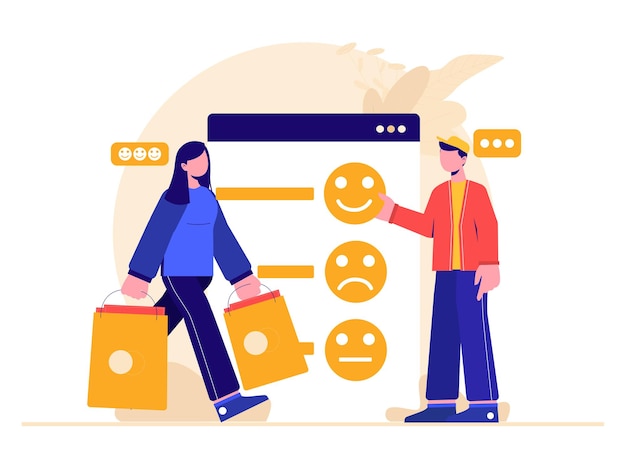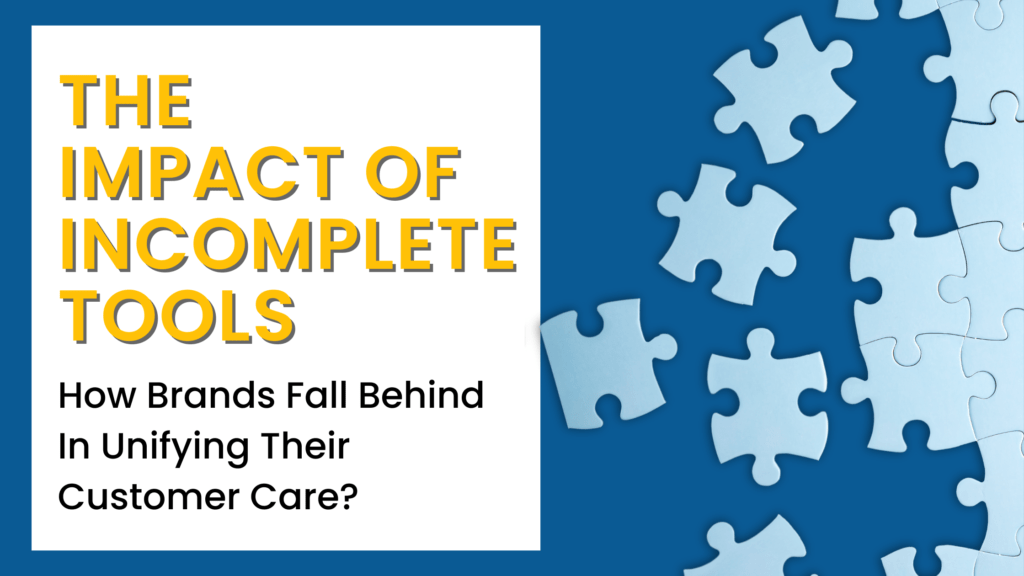Introduction
Today’s business landscape has become quite fast-paced and competitive. This is why brands need to deliver outstanding customer service. Having a seamless and consistent experience across all touchpoints is important to meet rising customer expectations. But, many brands face significant challenges in unifying their customer care due to incomplete tools and systems. Read on to explore the impact of incomplete tools on customer care. We will also share how brands can bridge the gap to stay ahead in the gameWhat is unified customer support?
A unified customer experience refers to a seamless and consistent interaction between a customer and a brand across all touchpoints and channels throughout the customer journey. It involves integrating various communication channels, data, and technologies to create a cohesive and personalized experience for every customer, regardless of how they choose to engage with the brand. The key aspects of a unified customer experience include:- Omnichannel Support
- Centralized Customer Data
- Consistent Brand Messaging
- Seamless Transitions
- Personalization
- Proactive Support
- Efficient Issue Resolution
- Feedback Integration

Understanding the Essence of Unifying Customer Care
Customer care goes beyond providing immediate assistance. The focus should be on making the complete customer journey a positive one. This is why brands should combine communication channels, data, and technology to create a unique and seamless experience for every customer.The Complex Landscape of Customer Care Channels
The modern consumer engages with brands across a variety of channels. Customers interact with their brands via email, social media, live chat, in-store, and more. Managing these channels can be difficult, especially when each tool is separate. A fragmented system leads to customers feeling disconnected from the brand. This ultimately leads to a poor customer experience and a dip in brand image and loyalty. Read about: Incredible Tools to Build an Engaging Omnichannel Customer Experience
The Pitfalls of Incomplete Tools in Customer Care
Incomplete tools create numerous hurdles for brands striving to deliver unified customer care. Some of the critical issues include:Lack of a Centralized Customer Database
Customer data scattered across various systems is difficult to maintain. When there is no centralized database, brands lack accurate and up-to-date customer profiles. This leads to sales and customer success teams asking customers for information that they may have shared before. When customers have to share the same information over and over, it leads to frustration. Learn more about: From Data To Personalization-Leveraging Social Analytics For Effective Buyer PersonasInability to Track Customer Interactions Across Channels
Using many tools in silos can lead to missing out on important insights about consumer behavior, preferences, and pain points. This also leads to a lack of seamless tracking of customer interactions. Lack of visibility hampers the ability to anticipate customer demands and provide proactive help. Read more: 12-Step Guide on How to Track Social Media AnalyticsMissing Omnichannel Support and Its Impact on Customer Satisfaction
Customers anticipate a seamless experience while switching between channels. Incomplete tools don’t provide omnichannel support, which results in fragmented interactions. As a result, customer satisfaction decreases. Do you know: How Does Omnichannel Improve Customer Experience? 7 Points to ConsiderTime and Resource Inefficiencies Due to Disconnected Systems
Managing disconnected channels is inefficient and makes it difficult for customer service staff to resolve problems. Brands need to focus on customer demands rather than spending time switching between platforms. Read about: How To Create A Seamless Omnichannel Contact Center?
What are the Consequences of Poorly Integrated Data?
When customer data is incomplete or not adequately integrated, brands face several adverse consequences:- Inaccurate Customer Profiles lead to Personalized Service Failures: Incomplete tools fail to gather comprehensive customer data. Having inaccurate customer profiles leads to low personalization. This makes it a challenge for brands to exceed customer expectations.
- Inefficient Issue Resolution and Increased Customer Churn: When data is not integrated between tools, customer care executives may not have access to the complete history of customer interactions. This can lead to longer resolution times and inefficiency, causing customer dissatisfaction.
- Lost Opportunities for Upselling and Cross-Selling: It is crucial to have unified customer care. This empowers brands to understand their customer’s preferences and past purchases, providing opportunities for targeted upselling and cross-selling. With fragmented systems, businesses miss the opportunity to capitalize on these opportunities, impacting revenue potential.
- Data Fragmentation Affecting Actionable Insights and Analytics: Disconnected data makes it challenging to derive meaningful insights and conduct in-depth analytics. Brands may struggle to identify patterns, trends, and customer sentiments, hindering their ability to make data-driven decisions.

Case Studies: Brands That Suffered from Incomplete Customer Care Tools
Let’s take a closer look at real-world examples of companies that faced significant challenges due to incomplete tools in their customer care:Case Study 1: Fabric Retailer’s Struggle with Siloed Systems
An online fabric shop has trouble maintaining consistent customer service across multiple channels. The phone support team was not concerned with customer interactions via email and chat. This caused information gaps and prolonged resolution times. Many customers complained about the lack of integration, which hurt their brand’s reputation.Case Study 2: The Social Media Customer Care Disaster at a Local Electronic Store
An electronics store in Bangalore had a separate team handling social media interactions. This team did not have access to the customer history in their traditional customer care system. The disconnect and lack of cohesive support frustrated customers. There were a series of viral complaints on social media, severely damaging the brand’s image.Case Study 3: Customer Dissatisfaction Due to Inconsistent Email Responses at a home-based tiffin service
In Mumbai, a subscription-based tiffin service used email as their main method of customer support. However, because their email and CRM systems were not integrated, clients frequently received inconsistent and delayed responses. Due to this, there was a spike in subscription cancellations and customer unhappiness.
The Key Benefits of Unifying Customer Care
Investing in comprehensive and integrated customer care tools offers several significant advantages for brands:- Improved customer satisfaction and loyalty: Unified customer care, consistent and tailored interactions boost customer happiness and loyalty.
- Greater Efficiency and Shorter Response Times: With all customer information easily accessible via a centralized system, agents are better able to handle problems, which results in shorter response times and a more effective support process.
- Smooth Channel Handoffs for a Wonderful Customer Journey: Smooth channel transitions made possible by unified customer service allow customers to carry on their conversations without having to repeat themselves.
- Expanded Possibilities for Proactive Customer Engagement: With thorough data insights, organizations may foresee customer demands and proactively engage with customers to provide tailored advice and support.

Strategies to Bridge the Gap and Unify Customer Care
Brands can implement the following strategies to overcome the challenges posed by incomplete tools:- Invest in integrated customer relationship management (CRM) software. This can develop a single perspective on each customer and centralize customer data and interactions.
- Adopt omnichannel customer support solutions. This can help brands deliver unified and seamless experiences across all channels.
- Train customer service representatives and give them more accountability. This can help them address complicated questions from customers and offer individualized solutions.
- Leverage artificial intelligence for a personalized customer experience. AI-driven chatbots and recommendation engines can improve personalization and speed up support procedures.
- Use sentiment analysis and social listening tools. These provide insightful information that can enhance customer service methods.
The Future of Unified Customer Care
The future of unified customer care provides intriguing potential as technology develops further: 1) Improvements in Technology: New developments in artificial intelligence (AI), machine learning, and data analytics will improve customer care procedures and allow for even more individualized and effective help. 2) The Impact of AI and Machine Learning: AI and machine learning will become more and more important in anticipating customer needs and providing real-time help. 3) Emerging Trends: Trends like voice-activated support, augmented reality, and virtual reality, will shape the future of customer support. This will further blur the distinctions between physical and digital interactions. Watch out: Unleashing The Power Of Customer Experience (CX) Trends – Revolutionizing Consumer-Facing IndustriesWhat can these rapid advancements and trends achieve for brands?
These exciting and revolutionary technological advancements hold the potential to completely change how businesses engage with their customers. Customer service strategies are being driven by both the quick development of technology and shifting client expectations. The future of unified customer care is:- customer-centric
- technology-driven
- geared toward delivering seamless and customized experiences across all channels

